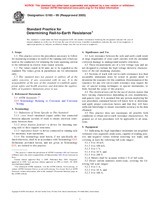We need your consent to use the individual data so that you can see information about your interests, among other things. Click "OK" to give your consent.
ASTM G165-99(2005)
Standard Practice for Determining Rail-to-Earth Resistance
STANDARD published on 1.5.2005
The information about the standard:
Designation standards: ASTM G165-99(2005)
Note: WITHDRAWN
Publication date standards: 1.5.2005
SKU: NS-57494
The number of pages: 5
Approximate weight : 15 g (0.03 lbs)
Country: American technical standard
Category: Technical standards ASTM
Annotation of standard text ASTM G165-99(2005) :
Keywords:
direct fixation, mass transit systems, running rails, track ballast, track-to-earth resistance, traction power substations, wooden tie, ICS Number Code 45.120 (Equipment for railway/cableway construction and maintenance)
Additional information
| Significance and Use | ||
|
Low resistance between the rails and earth could result in large magnitudes of stray earth currents with the attendant corrosion damage to underground metallic structures. These measurements are of a low voltage type and are not designed to evaluate the high voltage dielectric characteristics of the rail insulating elements. Sections of track with rail-to-earth resistances less than acceptable minimums must be tested in greater detail to determine the reason(s) for this condition. Determination of the reason(s) for any low rail-to-earth resistance may require the use of special testing techniques or special instruments, or both, beyond the scope of this practice. The electrical tests call for the use of electric meters that have varying characteristics depending on cost, manufacture, and generic type. It is assumed that any person employing the test procedures contained herein will know how to determine and apply proper correction factors and that they will have sufficient knowledge to ensure reasonable accuracy in the data obtained. This practice does not encompass all possible field conditions to obtain rail-to-earth resistance characteristics. No general set of test procedures will be applicable to all situations. |
||
| 1. Scope | ||
|
1.1 This practice covers the procedures necessary to follow for measuring resistance-to-earth of the running rails which are used as the conductors for returning the train operating current to the substation in electric mass transit systems. 1.2 The values stated in SI units are to be regarded as the standard. The values given in parentheses are for information only. 1.3 This standard does not purport to address all of the safety concerns, if any, associated with its use. It is the responsibility of the user of this standard to establish appropriate safety and health practices and determine the applicability of regulatory limitations prior to use. |
||
| 2. Referenced Documents | ||
|
We recommend:
Technical standards updating
Do you want to make sure you use only the valid technical standards?
We can offer you a solution which will provide you a monthly overview concerning the updating of standards which you use.
Would you like to know more? Look at this page.




 Cookies
Cookies
